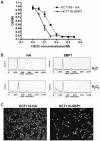Transcriptional regulation and biological functions of selenium-binding protein 1 in colorectal cancer in vitro and in nude mouse xenografts
- PMID: 19924303
- PMCID: PMC2774949
- DOI: 10.1371/journal.pone.0007774
Transcriptional regulation and biological functions of selenium-binding protein 1 in colorectal cancer in vitro and in nude mouse xenografts
Abstract
Background: It has been shown that selenium-binding protein 1 (SBP1) is significantly downregulated in different human cancers. Its regulation and function have not yet been established.
Methodology and principal findings: We show that the SBP1 promoter is hypermethylated in colon cancer tissues and human colon cancer cells. Treatment with 5'-Aza-2'-deoxycytidine leads to demethylation of the SBP1 promoter and to an increase of SBP1 promoter activity, rescues SBP1 mRNA and protein expression in human colon cancer cells. Additionally, overexpression of SBP1 sensitizes colon cancer cells to H2O2-induced apoptosis, inhibits cancer cell migration in vitro and inhibits tumor growth in nude mice.
Conclusion and significance: These data demonstrate that SBP1 has tumor suppressor functions that are inhibited in colorectal cancer through epigenetic silencing.
Conflict of interest statement
Figures



References
-
- Chang PW, Tsui SK, Liew C, Lee CC, Waye MM, et al. Isolation, characterization, and chromosomal mapping of a novel cDNA clone encoding human selenium binding protein. J Cell Biochem. 1997;64:217–224. - PubMed
-
- Porat A, Sagiv Y, Elazar Z. A 56-kDa Selenium-binding Protein Participates in Intra-Golgi Protein Transport. J Biol Chem. 2000;275:14457–14465. - PubMed
-
- Jeong J-Y, Wang Y, Sytkowski AJ. Human selenium binding protein-1 (hSP56) interacts with VDU1 in a selenium-dependent manner. Biochemical and Biophysical Research Communications. 2009;379:583–588. - PubMed
-
- Yang M, Sytkowski AJ. Differential Expression and Androgen Regulation of the Human Selenium-binding Protein Gene hSP56 in Prostate Cancer Cells. Cancer Research. 1998;58:3150–3153. - PubMed
Publication types
MeSH terms
Substances
Grants and funding
LinkOut - more resources
Full Text Sources
Other Literature Sources
Medical
Research Materials

